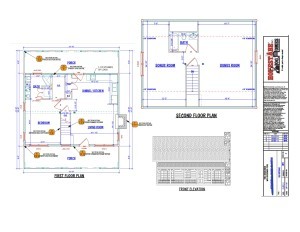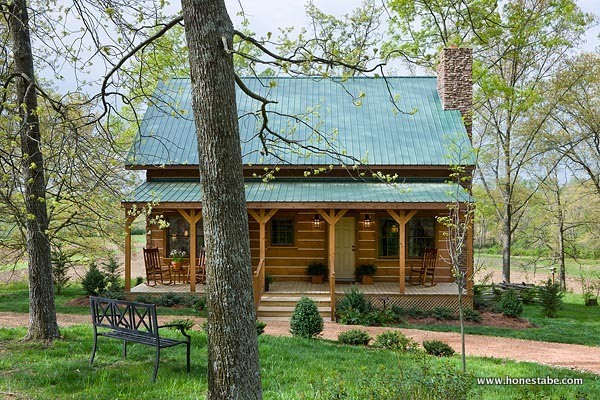by Sharron Bilbrey, Salesperson for Honest Abe Log Homes
By taking a walk back in time to get a glimpse of the log cabins built by early pioneers in the Smoky Mountains, one will discover time-tested styles and designs that reveal how these cabins have influenced log homes of today. But one does not have to look much further than Pastor Ken and Joy Clayton’s new Honest Abe Log Home as an example of the early frontier architectural legacy. Ken had been inspired by the mountain homes of the Smokies for over 50 years, and now he and Joy have fulfilled his life-long dream of building a log cabin in the traditional mountain pioneer style. As we examine the John Oliver home in Cades Cove and look at the Davis house in Cherokee, N.C., both built in the mid-1800s, and see how these early frontier cabins influenced the first Honest Abe log home designs in the late 1970s and early 1980s, it will become evident how the frontier tradition has been demonstrated in Ken and Joy’s new log home built in 2011.
Much of the tradition and heritage of the settlers in the Smoky Mountains is exemplified in a small community called Cade’s Cove. Year after year thousands of visitors to the Great Smoky Mountain National Park (established in 1934) will not complete their visit without touring the loop at the Cove. One of the main stops along the Cove circle is the John Oliver cabin. It has stood since 1850 as a testament to the rugged determination and ingenuity of the mountain settlers. Architecturally, it reflects the techniques and skills of European immigrants and represents a style typically found on the eastern frontier in the mid-1850s. (1)
The Oliver’s original Cades Cove cabin was built in 1822 and stood 50 yards or so behind the cabin that is still standing today and is preserved by The Great Smoky Mountain National Park service. This cabin, identified as the Oliver’s cabin, is actually the honeymoon house that their family built in 1850 for their son to use when he married. The honeymoon house boasted two stories of living space and was constructed with the hand hewn logs with notched corners. There are no pegs or nails as gravity locked them together. The open spaces between the logs (chinks) were filled with mud to seal out the rain and wind. (2) Most of the materials needed to build the cabins were natural to Cades Cove except for the luxury of the window glass.
This Oliver home, along with other Smoky Mountain frontier homes such as the T-shaped Davis house (seen at the Mountain Farm Museum in Cherokee, NC) , served as an inspiration to Rick Denton, the first president of Honest Abe, and to owner, Doug Smith, as they planned the first Honest Abe Log Home.
When Denton saw a picture of the Clayton home, he was taken aback as to how much it looked like the original Honest Abe model, called the Shenandoah. It and its “big sister,” the Springfield model, were featured in the first Honest Abe catalog in the early 1980s.
“Two of the first three models I sold were these models,” said Denton.
“This look was very popular in log home catalogs in the 1970s and 1980s,” Denton said. “They were a spin-off of the Oliver Cabin in the Cove, or a look-a-like of it.”
He explained that so many early pioneer cabins had this look, as well as another look that had a main section with a wing off the back.
“Many Clay County early homes of the late 1880s and early 1900s had this look,” he said. “This is the reason I always liked the look, and probably the reason I chose to build it as our original model. Almost every log home company had models such as this, and our contact base of prospects seemed to demand this look. We sold so very many of these models.”
One of the historical reasons for the popularity of this style (especially with a wing off the back like the Davis house in Cherokee, N.C.) was due to the length of supporting timbers. The main section and the wing were both fairly narrow. They had to be because lengths of structural timbers were often hard to get. By using two relatively narrow spaces, and shaping them in the form of a T or L, this provided quite a bit of space and a good look. The old fashion “Dog Trot” pioneer homes were also a variation of this style.
Usually, each space was no more than 16’ to 20’ wide, again because of length restrictions. Timbers had to span the space to support the first and second story spaces. It was easier to use the shorter lengths, and they were more abundant. This was the case for early pioneers and also for the 1970s and 1980s log home kit companies. There were no suppliers that could readily supply the log home companies with long structural timbers.
“We had to make do with what we had, similar to the early pioneers,” Denton said. “A full-length front porch was always a necessity. All the older pioneer homes had these porches. Usually, the back wings also had such a porch on it. Lots of porch space. All of our customers wanted this in the beginning, as they have throughout the years.”
Denton continued, “Regardless of the structural considerations, the look was the primary reason for choosing these models. They were a reflection of the log home pioneer look, and the look of early homes in our region. I always liked this style and thought it would be a good representation for our first model.”
 Honest Abe chose this style model to embody the pioneer spirit and the simpler life style that customers were seeking, and, in fact, are still seeking in a log home. (3)
Honest Abe chose this style model to embody the pioneer spirit and the simpler life style that customers were seeking, and, in fact, are still seeking in a log home. (3)
The desire for this cabin style lives on today as seen in the Ken and Joy home built by Honest Abe this summer. Ken had found a picture in an old Honest Abe Log Home catalog that had helped him explain to salesperson Sharron Bilbrey the type home he was looking for. The picture was one of the original Honest Abe models. Just like every couple who has built a home, the Claytons made compromises as they were planning. They both agreed that flat logs with dovetail corners were a must, but Ken wanted the traditional original chinked log style with the three inch chink line. However, Joy wanted a smaller chink line. They settled on our 6×12 Genesis log with dovetail corners, and Ken chinked both the inside and outside one-inch chink line, giving the home the flavor of the past he so desired.
The pioneer influence is seen all around and throughout the home. Ken built a split rail fence along his driveway. Joy has a hanging candle chandelier over her dining table using real candles instead of an electric fixture. There are no overhanging electric lights, only lantern sconces. There are timber ceiling beams, with no open vaulted areas, much like the earlier cabins. The higher walls created by the story and a half of logs gives a large bonus rooms upstairs that holds wall-to-wall beds for lots of grandchildren. And, of course, there are big front and back porches suitable for plenty of rocking chairs.
On the frontier when a family needed a home, the community would often come together for a log raising to help build the home quickly for the family. While the Honest Abe crew, headed by Joe Isenberg, built the Clayton home, several of Pastor Ken’s church members came to the job site to add their contributions as well. Some provided scripture verses in plastic bags that were stuffed in the foundation walls, and others wrote scriptures on the interior partition walls. Although the church members and community friends did not actually build the home like was done in an old-fashioned log raising, they provided prayers and blessings throughout the entire building project.
Pastor Ken and Joy just celebrated their first Christmas in their new Honest Abe Log Home. Their Christmas Open House was just one of many events, including back porch weddings, they plan to host at their new home. The Clayton’s are quick to give God all the glory and have dedicated this home to His service, and, at the same time, very grateful that God has provided the blessings to allow them to fulfill such a dream. Just as the John Oliver home has stood over time as evidence of the pioneer spirit of the early settlers of our nation, so the Clayton home will be left as a legacy to their children, grandchildren, and great grandchildren, their testimony that God’s “faithfulness is from generation to generation”. (4)
Photography In-Part by: Kenny Clayton
References:
(1) Daniel, Alice. Log Cabins of the Smokies. Great Smoky Mtns. Natural History Association, 2000.
(2) http://www.cadescove.net/cades_cove_pioneers.html
(3) Personal letter from Rick Denton, December 12, 2011
(4) Psalm 119:90
For more on the Great Smokey Mountains, visit SmokyMountains.com.




